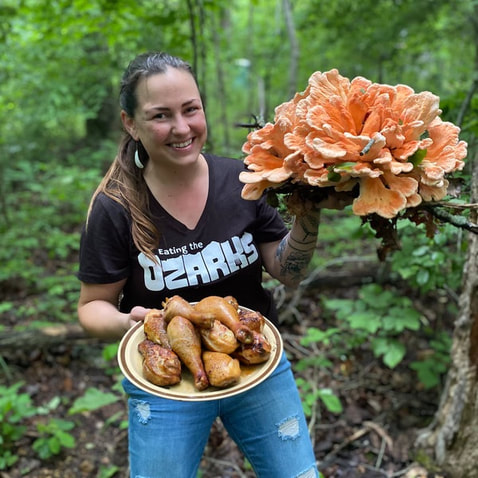This story is published in partnership with Ozarks Alive, a cultural preservation project led by Kaitlyn McConnell.

The concept of savoring the Ozarks has unique meaning for Rachael West, a forager and chef who specializes in found foods.
West leads Eating the Ozarks, an entity that exists to educate about the possibilities for foraged foods — and just recently published “Wild Foraged,” a cookbook that explains through words and photos how to prepare different plants found in Ozarks spaces.
“My book literally introduces you to a dandelion as if you've never met one,” said West, giving one example from the book. “It tells you about the people who loved the plant, who brought the plant here and used it. Then there’s 10 recipes on how to cook a dandelion.”
The book’s 200-plus pages are filled with about 20 different plants and ways to identify and integrate them into a reader’s food regime.
“I couldn’t cover everything, but the ones I cover are the most common,” West said. “All 50 states have at least 60 to 75% of the book, and here in the Midwest, it’s 100%.

“(The recipes) are very easy. I don’t put things like coconut flour or almond flour. I can suggest it, but I kept at a level for the lady who lives in the neighborhood who has never heard of foraging but her son’s into it, to the guy who's super into it and has every plant book but doesn’t know how to use them.”
West is not originally from the Ozarks, but made it her adopted home about a decade ago. She grew up in Texas, and while food has always been of interest and importance to her, it was in the Ozarks where her concentrated work to educate and inform others began.
“I think there's some part of me — I am definitely connected to sacred geometry. Or I've studied so much in patterns of nature that when I see something, it's like the plant is there and I see it in a different way — I don’t know, like a bee does,” West said. “I can immediately see the difference in the Virginia creeper and ginseng by sight, and most humans have to walk up and touch them.
“Because it came so easy, before long, I had learned hundreds of plants and was gathering.”
Teaching foraging in places near and far
As her knowledge and know-how grew, so did her public presence. Just one example is her participation in the Smithsonian Folklife Festival’s Ozarks program, which takes her to Washington D.C. for two weeks in 2023 to help educate visitors about regional plants and their uses.
Closer to home, her work is centered around Eating the Ozarks. Through the company, West leads classes, seminars and certification programs. She also caters events and hosts foraged-centric dinners — including an upcoming campout at Crystal Cave, complete with foods found locally.
In the midst of those efforts, West created “Wild Foraged” as a way to educate individuals as well as a resource for her classes.
“I wrote a book not to be a New York Times bestseller,” she said. “I wrote a book to be a great entrepreneur and to have a guide for my students. And I did that.”
She ultimately went the self-publishing route, which gave her control over the content and format.
“Nobody wanted both the foraging identification with the plant history, the first three pages of the plants’ chapters,” West said. “They only wanted the wild recipes. I was unwilling to not have the education part because the whole reason I wanted to assemble this book is because I own hundreds and hundreds of foraging books, even from the 1800s. I have every one I’ve ever come across, I grab and I pilfer and I ingest until it becomes me. I’m just obsessed.”
Originals and adaptations
The book’s pages are filled with photos and step-by-step directions for recipes featuring eastern redbud, wild garlic and wild onions, the aforementioned dandelion, mushrooms (including the famed morels and chicken of the woods), spicebush, curly dock and more.
Specific recipes include spicebush apple dumplings in syrup, sautéed red clover, rice pudding with dandelion syrup and black trumpet mushrooms, and “the best morel cream sauce.”
Some dishes West includes are her own creations, or those passed down through her family. Others have been adapted from her collection of books, which she has used to learn about other cultures and histories behind the plants on which she now educates.
“There’s a lot of both. I definitely didn't come up with the jelly recipes or things like that, except for just using the plant flour,” she said, noting recipes like ones for pancakes that were her great-grandmother’s, and another for curd and key lime that came from her mom. “I have a lot of old family recipes.”
Another example is an adaptation of a recipe for key lime curd West took from her mother.
“I used and juiced curly dock juice in place of my mom using the key lime,” West said of the plant that’s in the rhubarb family. “I just followed the amount of eggs and sugar. So yes, adapting, but more just like the ones that I already know or utilize.”
“Wild Foraged” is available via Eating the Ozarks’ website or on Amazon. For more information bout West’s classes and work, visit her Eating the Ozarks website.

